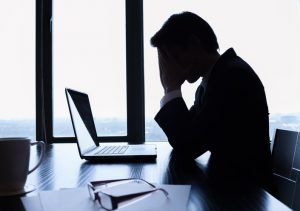Ed. note: This is the latest installment in a series of posts on motherhood in the legal profession, in partnership with our friends at MothersEsquire. Welcome Emily N. Litzinger to our pages. Click here if you’d like to donate to MothersEsquire.
Working mothers have always had a full, let’s be honest, overflowing plate of responsibilities balancing work and family. Even before the pandemic, the U.S. did very little to support working parents with a lack of resources and infrastructure to level the playing field. But moms, being the superheroes they are, made it work by cobbling together childcare and working late hours to keep up. But then the pandemic unexpectedly rips through everyone’s lives and the world of working mothers begins to crumble. What starts as a few weeks turns into months and months turns into nearly a year of remote schooling, scarcity in childcare, illness, shutdowns, business closures, and loss for so many Americans. All these factors coupled with the lopsided division of labor in heterosexual couples has resulted in an exodus of women leaving the U.S. workforce.
The Problem
In September, an eye-popping 865,000 women dropped out of the U.S. workforce — more than four times the number of men. Working mothers in heterosexual relationships are three times as likely to be responsible for the majority of the housework and childcare during the pandemic, one source reports. Studies find that full-time working mothers in two-parent households are on average doing around 22 hours of childcare a week during the pandemic, in addition to maintaining their jobs. This loss has set women’s progress in the labor force back to levels not seen since 1988. Shockingly, the Bureau of Labor Statistics reported that in December alone women lost 156,000 jobs while men gained 16,000. Every job lost in December was one held by a woman.
Women of color are even more adversely affected and of the 865,000 more than 324,000 were Latinas and 58,000 were Black women. Women of color are disproportionately represented in low-wage and high-contact service sectors such as restaurants, travel, and hospitality, which have seen the most closures and economic damage. The share of workers earning low wages is higher among Black and Latina women, reflecting the structural racism that has limited options in education, housing, and employment for people of color.
The Long-Term Impact To The Gender Gap
This trend coined the “shecession” has the threat of a long-term economic impact, the risk of losing women in leadership positions, future women leaders, and unwinding years of painstaking progress toward gender equality. The impacts could sideline an entire generation of women. Economists worry that if women decide to stay on the sidelines post-pandemic the dynamism of the U.S. economy is at risk with an estimated $64.5 billion per year lost in wages and economic activity. The U.S. economy simply cannot rebound without women in the workforce. The consequence from the pandemic could deadlock women’s earnings potential and career progression, and for women who leave the workforce during this time, re-entry could prove even harder than usual. Indeed, the loss for women continues long after the economy has bounced back with an atrophy of their skills, experience, and job prospects.
Pre-pandemic, the average U.S. female employee earned only 81 cents for every dollar the average male employee made. The pandemic’s disproportionate economic toll on women could create an even larger gender wage gap during and following the economic downturn. Historically, recessions moderately decrease the gender wage disparity since they tend to have a greater impact on men. While normal recessions close the gap by 2 percentage points, the pandemic’s recession is projected to widen the gap by 5 percentage points. Economists project that the average female worker will earn about 76 cents for every dollar the average male worker makes, and it will take more than 10 years for the wage gap to close to what it was before the pandemic.
Curbing The Negative Impact
We are a year into this pandemic, the consequences are palpable, and the future is uncertain. Now is the time for the legal businesses to plan for and act to curb the long-term damage to gender equality and the economy.
- Normalize Flexibility. Make a shift toward more progressive work policies. Even beyond the pandemic, normalize remote work and flexible work arrangements. Who says you must work a 9-5? Consider parent-friendly scheduling policies such as a compressed workweek, shorter workday, job sharing or part-time for positions where those options do not exist. Flexible scheduling supports juggling childcare and work and ultimately improves employee job satisfaction. Further, with a virtual workplace, the talent pool is limitless and enables legal businesses to recruit a higher caliber workforce.
- Continue Empathy. Leaders should communicate empathy and flexibility to workers. Train managers on how to support teams who are balancing childcare, isolation, and virtual schooling on top of their demanding workload. Ask employees what they need, how they feel, and if they are comfortable with the current work situation. Normalize talking about these feelings. One way is to start all meetings with a check-in with the group or share successes. Another example is to celebrate working mothers’ efforts. Compassion can go a long way.
- Communicate Openly and Frequently. Listen to the needs of working mothers and communicate openly and often. Working mothers are facing anxiety about the pandemic, childcare, and job security. Share regular updates on the state of the firm and any key decisions that impact employees’ lives such as pay and benefits.
- Empower Women Leaders. It is important for female leaders and other employees to connect with one another; help empower women in your law firm by organizing a forum for women leaders to come together to share ideas and connect. Implement programs and policies empowering women to achieve leadership roles such as equity partnership. Establish programs where female partners or leaders mentor women beginning their career or returning to work after the pandemic.
- Invest in Diversity and Inclusion Efforts. Studies have found that gender and racial diversity improve the quality of decision making, increase innovation, and improve reputation. In uncertain times and in an environment where many companies are pivoting their business model, a focus on recruiting and retaining a diverse workforce will lead to a richer talent pool and improved business efforts. Now is the time to sharpen your DEI agenda. Do not take your foot off the pedal!
- Commit to Pay Equity. Federal pay equity legislation is high on President Joe Biden’s priority list, and it should be high on legal businesses’ list as well. Companies should develop formal process to remediate pay inequities. To achieve pay equity, it is vital to track outcomes for promotions and raises by gender to ensure that women and men are being treated fairly and consistently. Perform an annual pay equity analysis to rectify any wage gaps.
- Act Now. Seize the moment. To rebuild our economies, we must start now to implement efforts to support women in the workforce and recruit those who have left during the pandemic. McKinsey forecasts that taking action now to advance gender equality means an additional $13 trillion to the global GDP in 2030 when compared with the gender-regressive scenario.
In a year marked by uncertainty and panic, legal businesses have an opportunity to make significant investments in building a more flexible and empathic workplace. The efforts, or lack of effort, will have consequences on gender equality and the entire economy for years to come.
 Emily N. Litzinger is a partner in the national labor and employment law firm Fisher Phillips and practices out of the Louisville office. Emily is a trusted adviser and experienced litigator who counsels and defends employers through the intricacies of labor and employment law and works with her clients to develop preventative strategies to ensure compliance and avoid costly litigation. Emily has a special interest in serving clients in the restaurant and hospitality industry and serves as on the Board of Directors for the Kentucky Restaurant Association. As a mother of three energetic young daughters, Emily is passionate about the advancement of women in both the legal profession and the workplace.
Emily N. Litzinger is a partner in the national labor and employment law firm Fisher Phillips and practices out of the Louisville office. Emily is a trusted adviser and experienced litigator who counsels and defends employers through the intricacies of labor and employment law and works with her clients to develop preventative strategies to ensure compliance and avoid costly litigation. Emily has a special interest in serving clients in the restaurant and hospitality industry and serves as on the Board of Directors for the Kentucky Restaurant Association. As a mother of three energetic young daughters, Emily is passionate about the advancement of women in both the legal profession and the workplace.



 Kathryn Rubino is a Senior Editor at Above the Law, and host of
Kathryn Rubino is a Senior Editor at Above the Law, and host of 


 Jill Switzer has been an active member of the State Bar of California for over 40 years. She remembers practicing law in a kinder, gentler time. She’s had a diverse legal career, including stints as a deputy district attorney, a solo practice, and several senior in-house gigs. She now mediates full-time, which gives her the opportunity to see dinosaurs, millennials, and those in-between interact — it’s not always civil. You can reach her by email at oldladylawyer@gmail.com.
Jill Switzer has been an active member of the State Bar of California for over 40 years. She remembers practicing law in a kinder, gentler time. She’s had a diverse legal career, including stints as a deputy district attorney, a solo practice, and several senior in-house gigs. She now mediates full-time, which gives her the opportunity to see dinosaurs, millennials, and those in-between interact — it’s not always civil. You can reach her by email at oldladylawyer@gmail.com.
 Jordan Rothman is a partner of
Jordan Rothman is a partner of 





